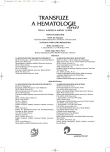Plasmatic concentration of soluble endoglin in patients with lymphoid malignancies
Authors:
L. Smolej 1; C. Andrýs 2; D. Belada 1; V. Maisnar 1; P. Žák 1; O. Široký 1; J. Malý 1
Authors‘ workplace:
Univerzita Karlova v Praze, Lékařská fakulta a Fakultní nemocnice v Hradci Králové, 2. interní klinika
1; Oddělení klinické hematologie a Ústav klinické imunologie a alergologie
2
Published in:
Transfuze Hematol. dnes,12, 2006, No. 1, p. 37-39.
Category:
Comprehensive Reports, Original Papers, Case Reports
Overview
Increased angiogenesis has been recently reported in acute and chronic leukemias, lymphomas, and myeloproliferative disorders. Endoglin (CD105), a member of transforming growth factor beta (TGF-beta) receptor family, modulates cellular responses to TGF-beta and is absolutely essential for angiogenesis. Its soluble form (sCD105) is increased in patients with various solid tumors. In our pilot study, we measured peripheral blood plasma concentrations of sCD105 using comercially available enzyme-linked immunosorbent assay in 75 patients with lymphoid malignancies and 13 healthy donors. We found a statistically significant increase in sCD105 concentrations in patients with B-cell chronic lymphocytic leukemia (n = 42) compared to the control group (p = 0.0296). Suprisingly, patients with multiple myeloma (n = 13) had significantly lower concentrations of sCD105 in comparison to controls (p = 0.0023). We didn’t find significant differences between sCD105 concentrations in patients with follicular lymphoma (n = 8) or diffuse large B-cell lymphoma (n = 12) and the control group. We conclude that plasma sCD105 is a new angiogenesis marker in lymphoid malignancies and together with other cytokines (such as VEGF - vascular endothelial growth factor and bFGF – basic fibroblast growth factor) might be useful as a part of complex angiogenesis assessment aimed to improve prognostic stratification of these disorders.
Key words:
endoglin, CD105, angiogenesis, myeloma, lymphoma, B-CLL
Labels
Haematology Internal medicine Clinical oncologyArticle was published in
Transfusion and Haematology Today

2006 Issue 1
Most read in this issue
- Real cost of chronic myeloid leukemia treatment with nonmyeloablative hematopoietic stem cell transplantation and comparison with cost of hypothetical imatinib treatment. What shall be considered in the cases of extremely costly medical procedures?
- Transmission of prion disease by blood and hot news in detection methods of abnormal prion protein
- Immunophenotyping of childhood leukaemias
- The use of alemtuzumab in allogeneic stem cell transplantation
